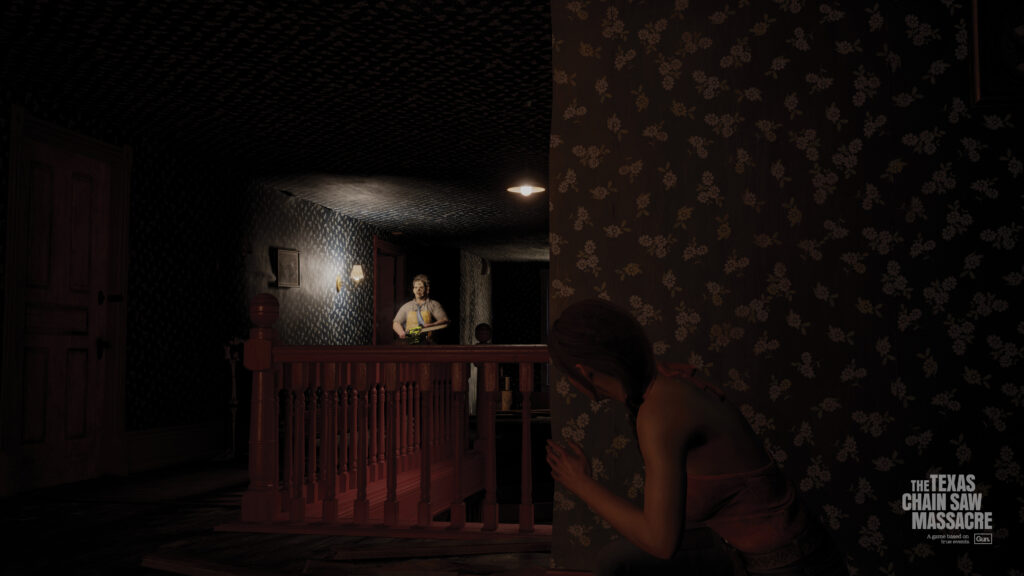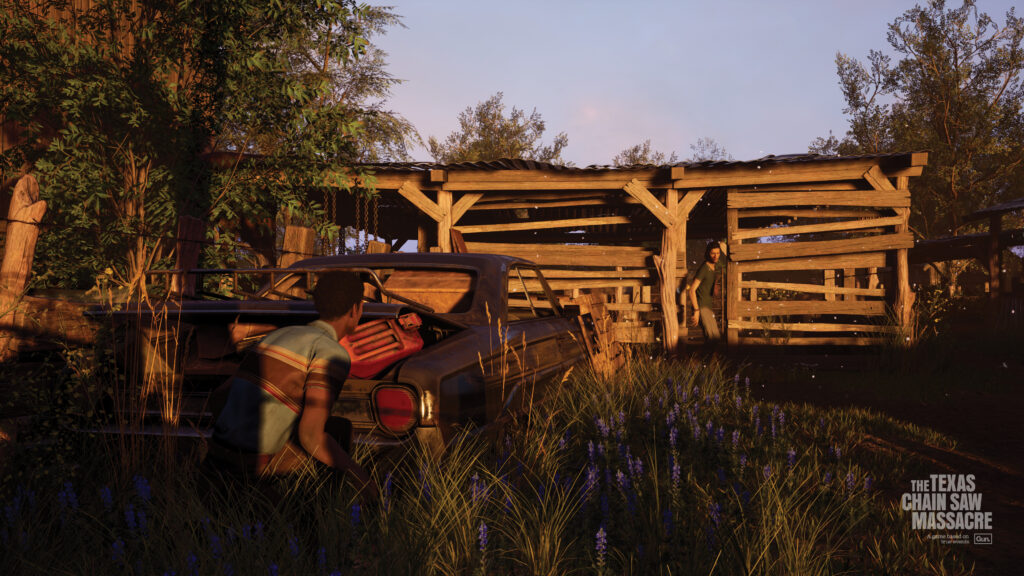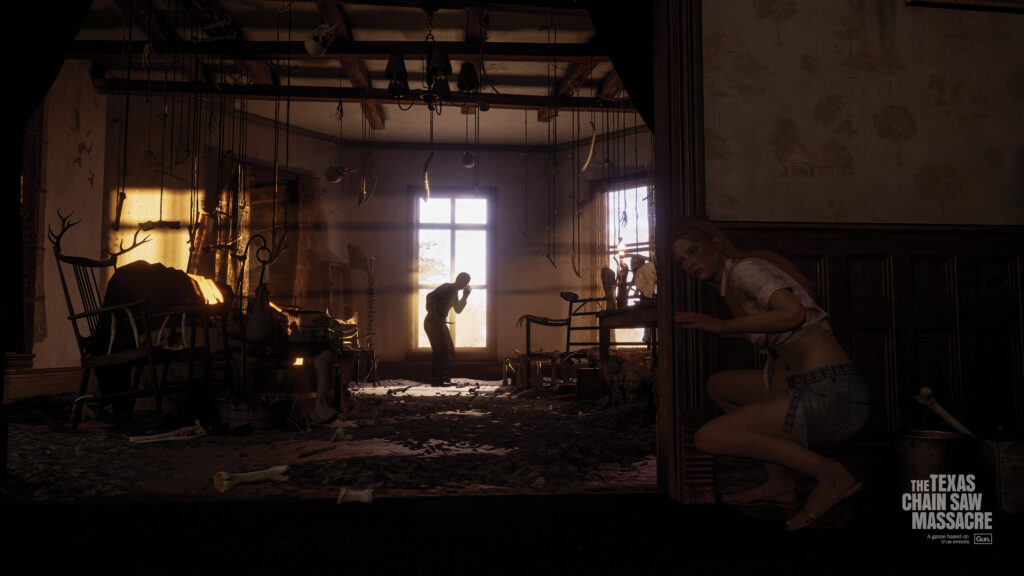Asymmetrical horror games have never had an easy time staying alive. While Dead by Daylight continues to thrive with more and more content events, games hoping to compete with Behaviour Interactive’s juggernaut of a title have either failed to garner a strong enough following or simply had their development cancelled altogether. One such competitor was Friday the 13th: The Game, published by Gun Interactive, which garnered a loyal fanbase but had development stalled due to legal and licensing issues with the franchise’s characters. Undeterred, Gun Interactive is taking another stab at publishing another entry based on a beloved horror franchise, this time with Tobe Hooper’s classic 1974 film The Texas Chain Saw Massacre.
The Texas Chain Saw Massacre pits a team of four young victims against three members of the diabolical Sawyer family. Like most asymmetrical horror games, the goal is for the victim team to escape the map, while family members try to hunt down their prey. Regardless of which of the three maps you’ll play on, victims all begin the match in the basement with Leatherface, while the other two members of the family start outside the basement to shore up exterior defenses. Victims will be able to gather a collection of items to aid in their escape, including lockpicks for opening doors, bone scraps to stun the family and disable traps, medicine for healing, and objective items uses to unlock new escape routes. Each of these maps has four to five different possible escape routes for victims, meaning that both teams will need to be crafty and adaptable to escape. Some of these escape routes largely require victims to pick a series of locks to exit an exterior gate, while using the valve or fuse exits will open time-sensitive doors that close after a few moments. Another unique feature to keep in mind is Grandpa, the withering patriarch of the Sawyer family. Family members can feed the old-timer blood to fuel his map-wide victim scanning abilities while gaining additional perks, while victims can stab Grandpa to slow the family’s progress.

One of the better features of The Texas Chain Saw Massacre are the unique playstyles for each victim. Unlike Dead By Daylight, whose survivors can all share their personal perks with each other once properly leveled up, each victim in this game possesses unique abilities to aid in their escape. For example, Sonny Williams can detect nearby victims and family, while Ana Flores can temporarily take vastly reduced damage from attacks. Additionally, each victim has a different set of stats, which adjust features such as their maximum health, speed at unlocking objectives, and ability to stay hidden. The combination of stat allocation and personal abilities helps make each victim feel uniquely suited to a different task. For example, Julie Crawford can temporarily avoid some family detection abilities, and when combined her stealth-focused stats make her a great candidate for sneakily handling objectives. If you wish to play a more combative victim, Leland McKinney’s high strength stats and ability to stun family members makes him a great choice for aggressive players.
For those who enjoy playing as a killer in asymmetrical horror games, The Texas Chain Saw Massacre does things a bit differently. Instead of focusing on hunting alone, playing as a member of the Sawyer family generally requires a lot of cooperation and teamwork, far more so than playing as a victim. Each of the five currently playable family members comes with strengths and weaknesses – Sissy or the Hitchhiker will offer you greater mobility to chase victims down, but if you’re looking for easier ways to spot hidden prey, Johnny or the Cook may be the right choice for you. As a team, coordination is the key to victory. It’s generally difficult to keep up with a victim in a sustained chase unless you’re Sissy or the Hitchhiker, but working alongside another family member to corner a victim is a highly efficient way to increase your kill count quickly. That being said, if you want to get consistent wins as a family member, I’d highly recommend using a headset to chat with your team, as this game does not have a ping system or anything like that to aid in team communications.

The infamous family is certainly not complete without Bubba Sawyer, the one and only Leatherface. As the franchise mascot, Leatherface plays a bit differently than the rest of his family. As mentioned earlier, he begins all matches in the basement, along with the other victims, and is the only member of the family who can destroy pathways and crawlspaces to deny victims an escape route in a chase. Uniqueness aside, Leatherface is an absolute blast to play. His trademark chainsaw hits like a bus and has a highly satisfying skill curve when it comes to trying to rev the weapon up at the perfect time to hit a victim for maximum damage. Additionally, while family players are still encouraged to mix-and-match different character combinations to create the ultimate hunting party, Bubba Sawyer has to be among the three characters on the family team in every match. This is in stark contrast to the victims, who can use any combination of four unique characters in each match. What this means for potential family players is that you will likely get stuck playing Leatherface at some point, regardless of whether you want to or not. Combined with the fact that players on both the victim and family teams each must play a unique character, bickering in pre-match lobbies over character selections will inevitably lead to longer matchmaking times.
Player progression comes in the form of Skill Points, which you can allocate to individual victims and family members to gain new perks to try out. There’s a good variety of perks, with options ranging from increasing the damage victims can deal to Grandpa to giving your family member a damage-over-time effect every time they hit a victim. Family players can also unlock character-exclusive perks focused on their signature abilities, including options that can buff Leatherface’s chainsaws or make the Cook’s padlocks harder to open. Players can also spend Skill Points to increase the stats of their victim or family member of choice, allowing you to build each character to cater to your preferred playstyle. This system allows for a great deal of build diversity – for example, Sonny has been my favorite victim due to his ability to detect family members through walls, so I nearly doubled his normally mediocre stealth stats to better suit my sneaky playstyle. Additionally, gaining experience with a specific victim or family member will unlock upgrades for their abilities, ranging from smaller changes such as reducing ability cooldowns to options that radically alter the ability altogether, such as allowing Leatherface to instantly activate his chainsaw. The developers at Sumo Digital generously encourage players to experiment with different perk, ability upgrade, and stat combinations, as choosing to respec your character and try out new upgrades is always free.

Like many multiplayer games on launch, The Texas Chain Saw Massacre is not without its’ balancing issues. While most of the victims seem fairly balanced, Connie Taylor’s ability to near-instantly unlock a locked door can lead to some blisteringly fast victim escapes if the Connie player brings the correct perks and the family doesn’t adapt fast enough. I’ve had numerous games as both victim and family where some victims will escape in less than 3 minutes, meaning some rebalancing will likely need to be done to make these highly efficient victim escapes harder to pull off. Victims aren’t the only party in need of some updates, either – there are some blatantly apparent balancing problems among the family members, as well. In particular, Johnny lacks the mobility or utility to compete with the other Sawyers, making it hard to justify bringing him into the match. On the other side of the spectrum, Sissy’s ability to simultaneously slow victims while scrambling their controls, when combined with her high mobility, makes her near-impossible to escape once she locates a weaker victim. Despite Connie and Sissy’s strengths, the biggest source of player contention at this time remains the Gas Station map, which features an escape route victims can open in less than a minute after exiting the basement if they have two lockpicks on hand. For family members to have a shot at winning at the Gas Station, bringing the Cook and using his padlocks to lock down this escape route is all but necessary. Combining this with Leatherface’s mandatory presence in all matches, this means family members can only really experiment with one of their three member choices in Gas Station matches. I am genuinely curious how Sumo Digital will handle the balancing for this game – Connie and Sissy’s strengths can likely be fixed by tweaking their numbers, but fixing the Gas Station will probably require more drastic measures.
The Texas Chain Saw Massacre makes heartfelt use of Tobe Hooper’s atmospheric vision, creating a sense of dread as victims navigate the dark, labyrinthine basement, only to emerge in a wilted, dusty exterior rife with slaughterhouses and grime. The visual presentation in this game is eerily gorgeous, excellently mirroring the original film’s portrayal of a sunbaked outback containing a seemingly innocuous home in rural Texas. This is matched by composer Ross Tregenza’s excellent soundtrack, rife with twisting chords and grinding beats that emulate Wayne Bell’s famous work. Horror fans will be delighted to hear those icons such as Kane Hodder and Scout Taylor-Compton provided motion capture work for this project, with Taylor-Compton also being the voice actor for Julie Crawford. Best of all, actor Edwin Neal returned to the Texas Chain Saw Massacre franchise for the first time since the original movie, reprising his famous role as the Hitchhiker. The sheer amount of detail and respect that went into this project is laudable, giving longtime fans a new way to experience the franchise while also paving the way for new blood.

The Texas Chain Saw Massacre lives up to the potential of its’ source material and then some. A good variety of playable characters and gameplay options keeps each match feeling fresh, despite some early balancing issues. With only three available maps to play at this time, The Texas Chain Saw Massacre will require consistent balance patches and content updates to preserve player engagement. Keeping the playerbase satisfied will be an especially important challenge for Sumo Digital, since the game’s character requirements may slow down matchmaking. As a complete package, this game effortlessly merges the film’s absurdist concept and grimy atmosphere to create one of the most tense and gripping multiplayer horror experiences out there. While asymmetrical horror games often end up dead on arrival, I have faith that the team behind The Texas Chain Saw Massacre have both the talent and passion needed to ensure that the Sawyer clan keeps coming back for second helpings.


